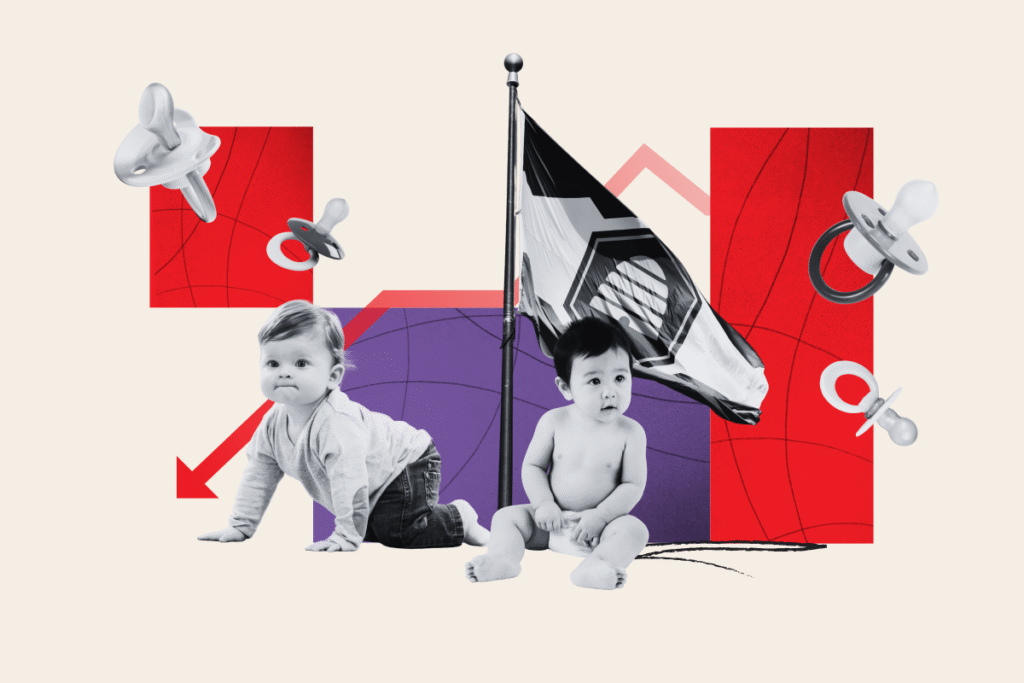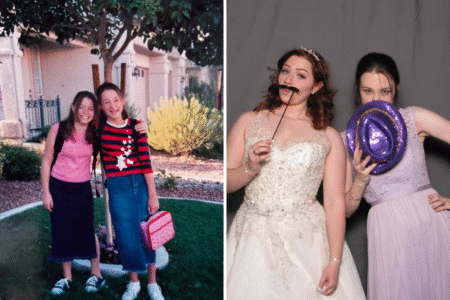For the last 50 years, people in Utah have consistently had more children than the rest of the country, but this gap has narrowed since 2010 and now there is very little to set the state apart from the nation, a new report shows.
In 1980, women in Utah were having 1.3 more children than the average American woman, a significantly bigger gap than in 2023, which was just 0.2, according to Utah Women and Leadership Project (UWLP) analysis published last week.
“From what I’ve seen across the research I’ve been doing for decades is that there are definitely generational shifts in attitudes and behaviors that impact nearly everyone, and Utahns are not immune to those shifts,” Susan R. Madsen, author of the report and founder of the UWLP, told Newsweek.
Indeed, the entire country, and much of the world, has seen a decline in births. In the United States, the fertility rate (the average number of children a woman has in her lifetime) is now projected to average 1.6 births per woman over the next three decades, according to the Congressional Budget Office’s (CBO) latest forecast released this year. That is below the replacement rate of 2.1 births per woman required to maintain a stable population without immigration.
Concerns about the birth rate are growing, usually over the fact that this demographic shift will contribute to an aging population, shrink the workforce, and strain public programs supporting the elderly.
The birth rate decline is a complex topic with no single cause but major cultural shifts and financial challenges in the aftermath of the 2008 crash are usually cited as the reasons—Newsweek has broken down the main causes being discussed in detail here.
Why Is Utah More Fertile Than Others?
“Fertility rates tend to be higher in more religious states like Utah,” Madsen said. “Typically, at least among many faith traditions, there is encouragement to (what Latter-day Saints refer to as) ‘multiply and replenish the earth’ (have children).”
Utah’s religious demography is unique, with 50 percent identifying as Latter-day Saints, according to the Pew Research Center’s Religious Landscape Study.
“The Church has a primary focus on the importance of families in its theology and practices, which means that a majority of residents have those same values,” Madsen said. “The importance of families is central to the doctrine and teachings of the Church. One of the most unique teachings in the Church is that families can be sealed in temples for eternity.”
Madsen said that while many faiths encourage having children, she believes the Church’s “messages about marriage and families being part of God’s eternal plan, as well as the role that parents play in loving and rearing their children in righteousness is stronger than in any other religion.”
Indeed, analysis by the Institute for Family Studies shows a connection between religion and births, finding that fertility rates among weekly-attending religious Americans have never dropped much below 2 children per woman.
Comparatively, fertility rates among less-than-weekly-attending Americans drops to around 1.7 and below 1.5 for nonreligious Americans, based on data from the National Survey of Family Growth (NSFG) from 1982 to 2019 and data from four waves of the Demographic Intelligence Family Survey (DIFS) from 2020 to 2022.
The frequency of attendance matters because the link between religion and fertility is about the practical ways religion impacts people’s lives, not just religion’s ideological values, family sociologist Nicholas H. Wolfinger previously told Newsweek.
Why Is Utah’s Fertility Plunging?
Utah’s fertility rate has not only dropped in line with the rest of the U.S., narrowing its gap with the nation, but it has actually fallen more than the country’s.
The state’s fertility rate has plunged by 45.5 percent from 50 years ago while America’s has declined 36 percent, according to UWLP.
“I expect Utah will remain higher than most states in terms of fertility, but the percentage of Latter-day Saints living in Utah has decreased through the years, which is one of factors it trends toward the nation,” Madsen said. “Retention is a concern for all faiths I believe, but because Utah has a more religious population, it impacts us differently.”
Newsweek covered how America’s ongoing shift from religion to secularism is affecting the birth rate in-depth here.
Meanwhile, Madsen’s study cited other widely discussed reasons for the birth rate decline, such as decreasing marriage rates and people having children later in life, and therefore fewer of them, often for financial reasons.
“Young couples are thinking about affordability,” she said. “Our housing prices skyrocketed during the pandemic. It is hard for our kids, let alone grandkids to stay in Utah if they want to purchase a house.”
On top of this, childcare is a major issue—75 percent of Utah a exists in a childcare “desert,” according to a 2024 Bankrate study, meaning there are not enough day cares to serve the population.
“Utah has been behind for years in workplaces providing family-friendly benefits as well,” Madsen said. “We are working hard on that, but more conservative legislatures like ours doesn’t want to impose more ‘rules’ or mandates on businesses. They want businesses to just do the ‘right thing’ and there is still a strong perception here that the ‘right thing’ for families is to have the woman stay at home with children.”
“But some of this doesn’t explain why we dropped so much,” she continued, going back to the impact of religion. “I do note that the ‘pressure’ through General Conference talks in the Latter-day Saint Church has eased through the years.”
General Conference is the Church of Jesus Christ of Latter-day Saints’ twice-yearly, worldwide gathering when the Church’s leaders deliver sermons, instruction, and announcements to members around the globe.
The Church’s president Dallin H. Oaks spoke about declining births and marriages during the most recent one held on October 4 and 5
“It is vital that Latter-day Saints do not lose their understanding of the purpose of marriage and the value of children,” Oaks said. “That is the future for which we strive…The national declines in marriage and childbearing are understandable for historic reasons, but Latter-day Saint values and practices should improve—not follow—those trends.”
“I don’t remember direct messages like this for a while,” Madsen, who is Latter-day Saint herself, said. “The Church leaders used to be more direct about having as many children as possible, but I don’t believe this is messaged any longer as directly.”
Madsen stressed that she also believes that larger gender divides in society is a reason (for declining birth rates) in Utah and beyond.
She cited a 2023 study carried out by Ruling Our eXperiences (ROX), the national nonprofit authority on girls, which found that 76 percent of girls believe that boys their age are not respectful of them.
This was based on a sample size of 17,502 girls surveyed in 2022 and 2023, the study disclaims a margin of error of 1 percentage point.
“If the gender divide (threated by each other) continues, I believe we’ll continue to see marriage and fertility rates decrease,” Madsen said.
Gender equality often plays a role in the birth rate conversation with several demographers and sociologists stressing that declining fertility is also illustrative of societal progress—namely more choice for women.
“Any time we see people being able to make fertility choices that suit their family, I think that’s a success,” global health economics professor Margaret Anne McConnell told Newsweek previously. “I think people choosing to have children later in life is also a success…To the extent that we can make it possible for people to reach whatever their desired family size is, I think that that would be a societal priority.”
Read Newsweek’s Full Interview With Susan R. Madsen Below
Can you explain why Utah has so consistently differed from the rest of the country?
Fertility rates tend to be higher in more religious states like Utah. Through the years, this statement has been supported by a various of studies and demographic surveys like Pew Research and the National Survey of Family Growth. Typically, at least among many faith traditions, there is encouragement to (what Latter-day Saints refer to as) “multiply and replenish the earth” (have children). Hence, Utah has been among the highest fertility rates as members of The Church of Jesus Christ of Latter-Day Saints make up at least half of Utahns population (probably higher, but don’t have a percentage).
The Church has a primary focus on the importance of families in its theology and practices, which means that a majority of residents have those same values. The importance of families is central to the doctrine and teachings of the Church. One of the most unique teachings in the Church is that families can be sealed in temples for eternity. To your question: This consistent messages about marriage and families being part of God’s eternal plan, as well as the role that parents play in loving and rearing their children in righteousness, I believe is stronger than in any other religion. Hence, it does set aside Utah from the rest of the country – although in many faiths’ families are important as well.
Do you think it’s now on its way to catching up with the rest of the country?
It is definitely trending toward the national patterns as you see in our report. I expect Utah will remain higher than most states in terms of fertility, but the percentage of Latter-day Saints living in Utah has decreased through the years, which is one of factors it trends toward the nation.
A decrease in activity levels (aligned with commitment to teachings) could be another reason for having less children. Retention is a concern for all faiths I believe, but because Utah has a more religious population, it impacts us differently.
What do you think has changed for Utah?
From what I’ve seen across the research I’ve been doing for decades is that there are definitely generational shifts in attitudes and behaviors that impact nearly everyone, and Utahns are not immune to those shifts. We follow national trends so at least some of the causes for the nation/global decline are true in Utah. Like other states, when the age of marriage goes up, fertility rates decrease, and our age of first marriage has gone up.
What do you see as the primary drivers of this decline?
There have definitely been a change in age at first birth, which has impacted the number of children. People just have less kids today, but you still see families with 3+ kids in Utah often. Our marriage rates have decreased too, but some of this doesn’t explain why we dropped so much. I do note that the “pressure” through “General Conference” talks in the Latter-day Saint Church has eased through the years, but last week in our semi-annual general conference, there was a specific talk (forgetting who – maybe Dallin H. Oaks) that said this.
I don’t remember direct messages like this for a while. The Church leaders used to be more direct about having as many children as possible, but I don’t believe this is messaged any longer as directly. Also, more and more Utahns, particularly in the 20-40 age range are absolutely worried more these days about money/economic factors. I was just saying to my husband the other day, that when we (I’m Latter-day Saint if you couldn’t tell) we taught to just go forward with faith and it will all work out! I don’t see that as much. Young couples are thinking about affordability. Our housing prices skyrocketed during the pandemic. It is hard for our kids, let alone grandkids to stay in Utah if they want to purchase a house.
I’m in economic conversations with other leaders often about this issue. Utah is working hard to figure out how to find solutions to this. There are more multi-generational family homes. Also, if you have children, childcare is so unaffordable. In some rankings, Utah is included as a “childcare desert”. This is important, because if you have 2 parents in the home, in most cases both parents need to be employed. Utah has been behind for years in workplaces providing family-friendly benefits as well. We are working hard on that, but more conservative legislatures like ours doesn’t want to impose more “rules” or mandates on businesses. They want businesses to just do the “right thing” and there is still a strong perception here that the “right thing” for families is to have the woman stay at home with children. There is still a strong view here that childcare is a “private issue” not a “public issue” and therefore it is a challenge for two parents to work, so if they don’t, they cannot afford and may impact their views about number of children they can afford. As with other places in the nation, children are so busy with so many things (sports, music, extracurriculars) that younger people are paying attention at what it takes to raise children.
I do want to say that I think the larger gender divides in society is a reason in Utah and beyond. If the gender divide (threated by each other) continues, I believe we’ll continue to see marriage and fertility rates decrease.
Read the full article here














